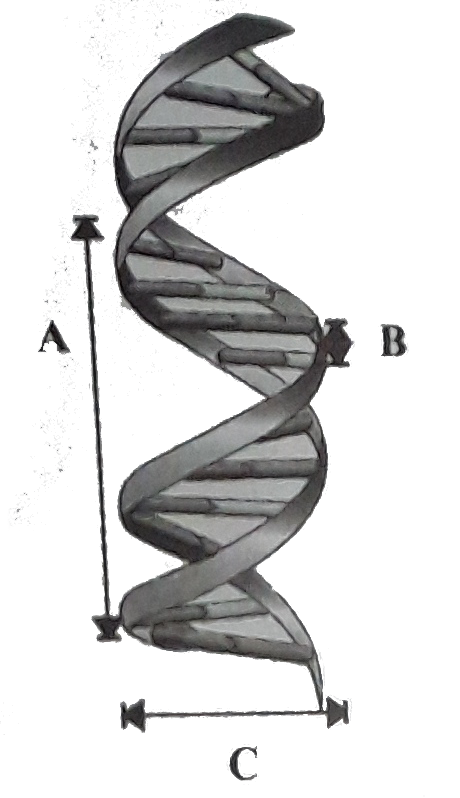The helical model for DNA given by Watson and Crick was
B type right handed
Z type left handed
B type left handed
Z type right handed
The correct Answer is:A
To answer the question regarding the helical model for DNA proposed by Watson and Crick, we can follow these steps:
1. Understanding the Structure of DNA:
- Watson and Crick proposed that DNA is structured as a double helix. This means it consists of two strands that are twisted around each other.
2. Identifying the Type of Helix:
- The helical model described by Watson and Crick is specifically known as the B-type DNA, which is a right-handed helix. This means that if you were to follow the twist of the helix with your right hand, your thumb would point in the direction of the helix's twist.
3. Base Pairing:
- In the double helix, the strands are held together by base pairing. The bases pair specifically: adenine (A) pairs with thymine (T), and guanine (G) pairs with cytosine (C). This base pairing is crucial for the stability of the DNA structure.
4. Characteristics of B-DNA:
- B-DNA is characterized as being wider and shorter compared to other forms of DNA, such as A-DNA and Z-DNA. It is the most common form of DNA found in cells.
5. Conclusion:
- Based on the information above, the correct answer to the question is that the helical model for DNA given by Watson and Crick was a B type right-handed helix.
Final Answer:
The helical model for DNA given by Watson and Crick was B type right-handed.
---
- Watson and Crick proposed that DNA is structured as a double helix. This means it consists of two strands that are twisted around each other.
- The helical model described by Watson and Crick is specifically known as the B-type DNA, which is a right-handed helix. This means that if you were to follow the twist of the helix with your right hand, your thumb would point in the direction of the helix's twist.
- In the double helix, the strands are held together by base pairing. The bases pair specifically: adenine (A) pairs with thymine (T), and guanine (G) pairs with cytosine (C). This base pairing is crucial for the stability of the DNA structure.
- B-DNA is characterized as being wider and shorter compared to other forms of DNA, such as A-DNA and Z-DNA. It is the most common form of DNA found in cells.
- Based on the information above, the correct answer to the question is that the helical model for DNA given by Watson and Crick was a B type right-handed helix.
The helical model for DNA given by Watson and Crick was B type right-handed.
Topper's Solved these Questions
- ANIMAL TISSUES BOOK - TRUEMEN BIOLOGY ENGLISHCHAPTER - ANIMAL TISSUES EXERCISE - MULTIPLE CHOICE QUESTIONS
193 Videos
- CELL- THE BASIC UNIT OF LIFE ( CELL AND ITS STRUCTURAL ORGANISATION )BOOK - TRUEMEN BIOLOGY ENGLISHCHAPTER - CELL- THE BASIC UNIT OF LIFE ( CELL AND ITS STRUCTURAL ORGANISATION )EXERCISE - MULTIPLE CHOICE ANSWER TYPE
308 Videos
Similar Questions
Knowledge Check
In the double helix model of DNA as proposed by J. D. Watson and F.H.C. Crick, each base pair is how far from the next base pair?
A0.034 nmB0.34 nmC3.4 nmD34 nmGiven figure represents the DNA double helix model as proposed by Waston and Crick (1953). Select the option that shown correct measurements of A, B and C.
 AA-3.4nm,B-0.34 nm, C-2 nmBA-3.4nm, B-3.4nm,C-20nmCA-3.4Å,B-3.4Å, C-20ÅDA-34 Å,B-3.4Å , C-2Å
AA-3.4nm,B-0.34 nm, C-2 nmBA-3.4nm, B-3.4nm,C-20nmCA-3.4Å,B-3.4Å, C-20ÅDA-34 Å,B-3.4Å , C-2Å
Double helix model of DNA which was proposed by watson and crick was of-
View SolutionGeocentric model was given by
View SolutionThe first model of an atom was given by
View SolutionDefine nucleic acid. Describe the structure of DNA model proposed by Watson and Crick.
View SolutionThat background information did Watson and Crick have made available for developing a model of DNA ? What was their contribution ?
View SolutionAssertion. DNA is more stable while RNA is more reactive.
Reason. DNA was first discovered by Watson and Crick (1953).
View Solution
